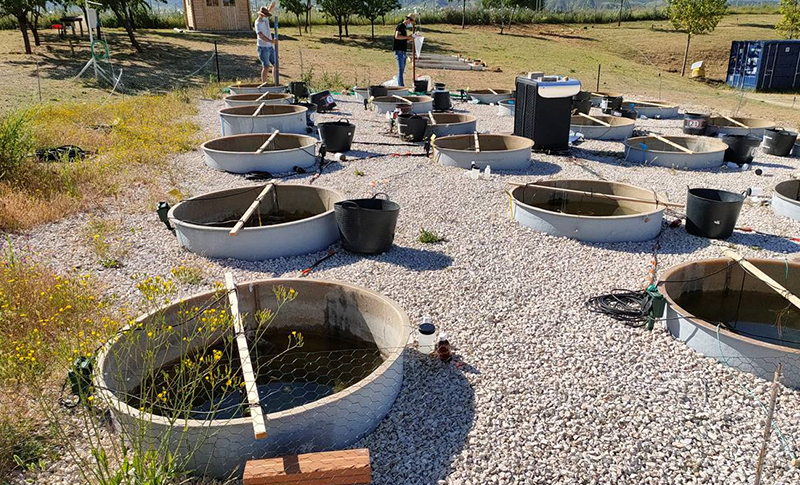The toxicity of pesticides for aquatic life is usually measured at a constant temperature. But that is not appropriate, shows research by Markus Hermann, a PhD candidate at Wageningen Environmental Research. Using apparatus he designed himself, he simulated the impact of warming (+4°C) and heatwaves (+8°C) on the effect of the widely used ‘bee poison’ imidacloprid and the fungicide carbendazim.
Hermann’s climate machine is essentially a piece of equipment that lets him create any temperature regime he wants in ecosystems, both large and small, he makes himself. Such an ecosystem is basically a kind of aquarium with aquatic organisms, plants and sediment. But without fish, because the ecosystems he uses are too small for that.
The research was prompted by an article from 2019. ‘A young researcher had discovered a pesticide could be six times more toxic than thought if you took the daily variation in temperatures into account in the study. Tests are normally done at a constant temperature. My work takes experiments with multiple stressors to an ecologically more realistic level.’
The results are more realistic, but the interpretation is also more complex. That applies to the effecting of global warming, for example. Pesticides may break down faster when temperatures are higher. ‘I see that in my experiments too,’ says Hermann. ‘But that doesn’t necessarily mean warming is a good thing. The breakdown products of a pesticide can be more toxic than the pesticide itself, for example.’
Rapid reproduction
What is more, organisms differ in how sensitive they are to warming and pesticides. Dragonfly larvae even seem to thrive with climate change. ‘One possible explanation,’ says Hermann, ‘is that some organisms respond to stress by reproducing more quickly. But the question is: how long will that effect continue? Is the increase in numbers only a short-term effect, and will the population eventually decline after all because conditions become too stressful?’
It is not the general warming but the extreme weather that poses the greatest threat for the future
Markus Hermann, a PhD candidate at Wageningen Environmental Research
An increase in the temperature speeds up the metabolism, which leads to faster population growth, as Hermann’s experiments show. In that sense, climate change can have a positive effect. ‘But as soon as insecticides are included in the mix, the situation can go in reverse. The positive temperature effect does not offset the impact of the pesticides.’
Disastrous
A test Hermann did with insects showed how disastrous the combination of imidacloprid and heat can be. The biomass of insects fell by almost 50 per cent during the experiment. ‘These were insects that were caught on the water’s surface. So it is not only the larval stage that is affected, it’s the whole life cycle of the insects. Studies like this are rare because they are so labour-intensive.’
So Hermann believes extreme weather should be taken into account more in the chemical risk assessment of pesticides. ‘Extreme weather can be quite devastating and destroy whole populations because the organisms are not able to adapt or recover. It is not the general warming but the extreme weather that poses the greatest threat for the future.’

 Research location in Spain where PhD candidate Markus Hermann studies temperature regimes in ecosystems he creates himself (a kind of aquarium with aquatic organisms, plants and sediment). Photo Markus Hermann
Research location in Spain where PhD candidate Markus Hermann studies temperature regimes in ecosystems he creates himself (a kind of aquarium with aquatic organisms, plants and sediment). Photo Markus Hermann 

